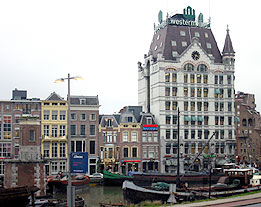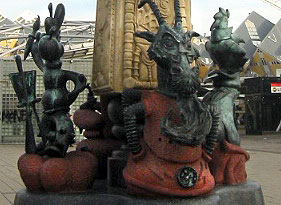
| « Haarlem | 100 Years of Turbulence » |
I was predisposed to like Rotterdam sight unseen, on historical grounds. Rotterdam had been utterly destroyed in the Second World War, just like my own hometown of Warsaw, and had to be rebuilt from the ground up after hostilities ended. Unlike Warsaw, however, the job hadn't been done by Stalinists, and this had to be a good thing.
Say what you will about the Germans, but when they set out to level an urban center, they don't cut corners. The city was flattened by an air raid at the very outset of the Nazi invasion of the Netherlands in 1940. Despite being hugely outnumbered and having to defend a country that was topographically challenged, the Dutch had put up unexpectedly stiff resistance. The Germans decided to issue an ultimatum: if the Dutch didn't surrender immediately, the Luftwaffe would begin destroying cities, starting with Rotterdam and Utrecht.
The threat worked - Holland capitulated right before the deadline - but the Germans went ahead and bombed Rotterdam anyway because - hey! - they were Nazis. The raid killed 900 people and destroyed 25,000 buildings, essentially the entire city center. There is one lone block left of Old Rotterdam:

Rather than restore the old town after the war, the Dutch authorities signed the city over to a variety of young architects, who did their best to make the place look modern and interesting. As a result of their labors, a large part of the city looks like the senior thesis of a talented and precocious architecture major, albeit one who was heavy into drugs. There are bright colors and unusal shapes everywhere, and many of the buildings seem to be answering questions of the form "Wouldn't it be cool if...":




While some of the showplace architecture looks a little silly, the overall effect is surprisingly pleasant and harmonious. Rotterdam is still the busiest port in Europe, and has a substantial immigrant population. Both factors temper the preciousness of the design and give the city a lively street life to go with all the fancy buildings. The Maritime Museum has an impressive exhibit that shows all of the nautical activity at any given moment, projected onto a giant wall display that looks like a heavy travel day at New York area air traffic control. There are 200,000 ship movements every year in and out of Rotterdam harbor. From here you can travel by inland waterway to Lyon, or Budapest, or the Black Sea.
I spent my two days in Rotterdam in the Hotel Aram, a dingy little establishment on the western side of the city. Just closing the windows in the room was enough to give me a massive nicotine rush, but at least my inner miser was happy. In the evenings there was a cozy nearby cafe to escape to, where the cigarette smoke was fresher. Belgian beer makes up for a multitude of sins.

Rotterdam is spacious and nice to walk through - there's a sort of linear park down the middle of the city, leading from the train station, built to resemble a canal. And tucked in among the corners of the city are genuine canals, many of them residential (judging by the profusion of upscale houseboats). The city is built across both sides the river Maas, with a wide riverwalk that looks like it's the center of Rotterdam night life in the warmer months.
I paid a long visit to the Museum Boijmans Van Beuningen, which has a stunning collection of paintings even by Dutch standards. Like many of the other museums I visited in the Netherlands, it takes care to display its pictures in small rooms, so that you see them on a more intimate scale. This is a beautiful way to show old Dutch paintings, given the obsessive level of detail. It also means you often find yourself alone in a room with a celebrity painting, the kind shown to bored freshmen in every 'Introduction to Western Art' college course, without so much as a scowling guard to distract you.
The Boijmans Museum also has some memorable efforts by members of the Old Master farm team. I especially liked a painting by the most excellently named Jan Baptist Weenix, which has to be one of the few depictions in European art of a bird shitting in the eyes of a sleeping man. The picture is called "Tobit, sleeping under a vine, is blinded", and comes to us straight from Holy Scripture:
I did not know there were birds perched on the wall above me, till their warm droppings settled in my eyes, causing cataracts. I went to see some doctors for a cure, but the more they anointed my eyes with various salves, the worse the cataracts became, until I could see no more. For four years I was deprived of eyesight, and all my kinsmen were grieved at my condition. Ahiqar, however, took care of me for two years, until he left for Elymais. [Tobit 2:10]
Tobit 2:10 is the Idle Words inspirational Bible verse of the day.
Another Old Testament winner is a 1648 picture by Frans Post, which depicts a stock Biblical scene with various anacondas and armadillos lurking in the shrubbery - think Boaz meets the Crocodile Hunter. It's called "Brazilian Landscape with Manoah's Sacrifice", and I like the baldness of just moving the action to someplace the painter found more fun to paint than the dusty old Levant.
I also enjoyed "The Pancake Bakery", a food painting by Peter Aertsen from roughly the same period. It's comforting that a fondness for stacks and stacks of pancakes transcends the boundaries of time and culture. The pancakes are so numerous, so fluffy, and so modern-looking (compared to the staid baker and his family, certainly) that the picture looks like a postmodernist put-on. You keep expecting to see Mrs. Butterworth peeking out from behind a short stack. But it's the genuine article, and a survey of other pictures by Aertsen suggests that there is often a flapjack or waffle loitering in the background, like a Frans Post armadillo.
Tucked in among these all curiosities are two paintings by Pieter Breughel and Hieronymous Bosch that, if you were to get up from your computer right now and take the next first-class flight to Rotterdam, would justify the entire trip.
| « Haarlem | 100 Years of Turbulence » |
brevity is for the weak
Greatest Hits
The Alameda-Weehawken Burrito TunnelThe story of America's most awesome infrastructure project.
Argentina on Two Steaks A Day
Eating the happiest cows in the world
Scott and Scurvy
Why did 19th century explorers forget the simple cure for scurvy?
No Evidence of Disease
A cancer story with an unfortunate complication.
Controlled Tango Into Terrain
Trying to learn how to dance in Argentina
Dabblers and Blowhards
Calling out Paul Graham for a silly essay about painting
Attacked By Thugs
Warsaw police hijinks
Dating Without Kundera
Practical alternatives to the Slavic Dave Matthews
A Rocket To Nowhere
A Space Shuttle rant
Best Practices For Time Travelers
The story of John Titor, visitor from the future
100 Years Of Turbulence
The Wright Brothers and the harmful effects of patent law
Every Damn Thing
Your Host
Maciej Cegłowski
maciej @ ceglowski.com
Threat
Please ask permission before reprinting full-text posts or I will crush you.